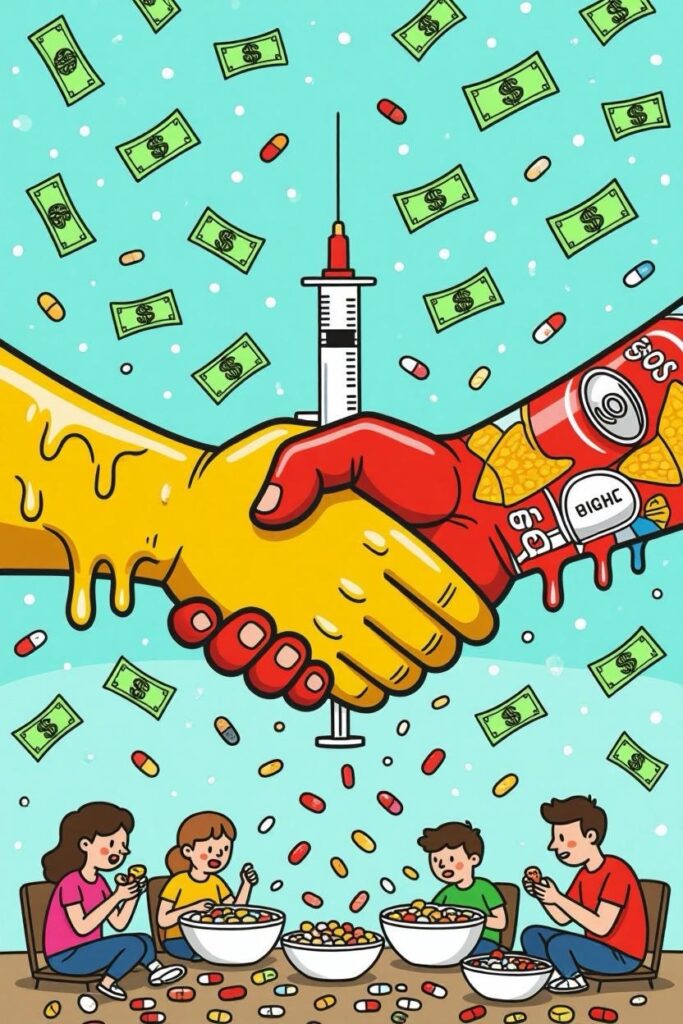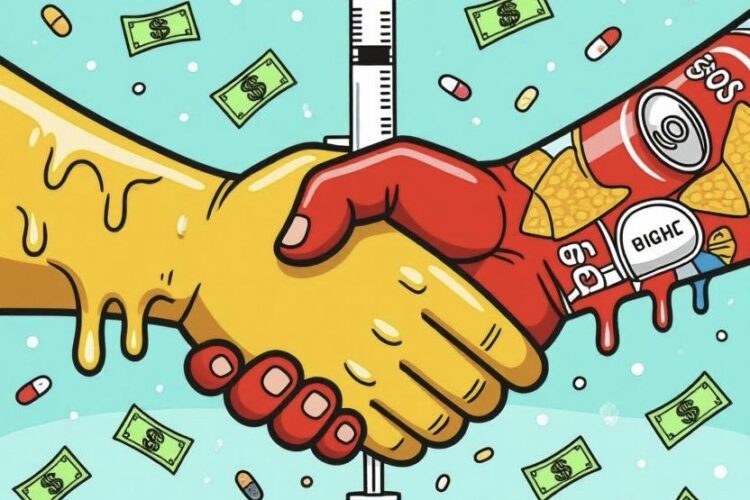Big Pharma and Big Food fuel a health crisis through ultra-processed foods (UPF) like sodas and snacks, packed with sugar, fat, and additives. These hyper-palatable products, classified as Nova group 4, drive obesity, diabetes, heart disease, and liver issues, exploiting addictive properties. Big Food uses tobacco-like tactics—lobbying, kid-targeted marketing, and distorted science—while Farm Bill subsidies keep UPF cheap. Big Pharma profits with drugs like Ozempic and Wegovy to treat resulting diseases. Conflicts of interest taint dietary guidelines, and lawsuits against companies like PepsiCo and Nestlé seek accountability for deceptive practices. Movements like Make America Healthy Again push for reform, promoting whole foods and stricter regulations. Breaking this cycle requires transparent policies, better food access, and consumer awareness to curb the health toll and corporate profits.
Long Version
In Cahoots: The Unholy Alliance Between Big Pharma and the Ultra-Processed Food Industry
The pharmaceutical industry and the food industry have long operated in a symbiotic relationship, where Big Pharma profits from treating the chronic diseases fueled by Big Food’s ultra-processed foods and junk food. This collusion creates a cycle of dependency: processed food and fast food laden with sugar, fat, salt, and additives drive health crises like obesity and diabetes, while Big Pharma cashes in on medications to manage the fallout. Critics argue this partnership mirrors the tobacco playbook, prioritizing profits over public health through lobbying, conflicts of interest, and predatory marketing.
The Rise of Ultra-Processed Foods and Their Hidden Dangers
Ultra-processed foods, or UPF, dominate modern diets, classified under the Nova classification system as Nova group 4—industrially produced edible substances engineered for maximum appeal and shelf life. These include items like sodas, packaged snacks, and ready meals from companies such as PepsiCo, Nestlé, and General Mills, packed with high-fructose corn syrup, emulsifiers, flavor enhancers, and non-nutritive sweeteners. Unlike minimally processed food, UPF creates an obesogenic environment, where hyper-palatable products exploit biologically addictive properties to encourage overconsumption.
This shift began in earnest during the 1980s and 1990s, when cigarette companies like Philip Morris and R.J. Reynolds acquired major food brands, applying the cigarette playbook to make products addictive. They transferred addiction specialists from tobacco to food divisions, using colors, flavors, and marketing tactics to target vulnerable groups, much like Big Tobacco did with children. Today, UPF constitutes over 60% of the average American’s calorie intake, contributing to a commerciogenic landscape where food deserts limit access to fresh options, forcing reliance on cheap, addictive junk food.
The health toll is staggering. Regular UPF consumption is linked to obesity, Type 2 diabetes, heart disease, cancer, and metabolic dysfunction-associated steatotic liver disease (MASLD), formerly known as non-alcoholic fatty liver disease (NAFLD). Antibiotic resistance also emerges from factory farming practices tied to Big Farming, where animals are pumped with drugs to produce cheap meat for processed products. Children face predatory marketing, with ads glorifying sugary cereals and sodas, leading to early-onset chronic disease and food addiction that rivals substance dependencies.
Industry Tactics: Lobbying, Marketing, and the Tobacco Analogy
Big Food employs the tobacco playbook to deflect blame and maintain dominance. This includes distorting science, emphasizing personal responsibility, and lobbying against regulation. Conflicts of interest abound: 95% of the 2020 Dietary Guidelines Advisory Committee members had ties to food or pharma giants like Kellogg, Abbott, and Kraft, influencing recommendations that downplay UPF risks. Subsidies via the Farm Bill disproportionately fund UPF ingredients, keeping prices low and profits high for conglomerates.
Marketing to children echoes Big Tobacco’s strategies, using cartoons and flavors to hook young consumers. Health organizations partner with these industries for credibility, while lobbying stifles reforms. In the UK, similar ties to Tate & Lyle and Unilever taint nutrition advice. This creates a health crisis where chronic diseases cost trillions, benefiting shareholders through share buybacks and dividend payouts.
Big Pharma’s Profitable Role in the Cycle
Enter Big Pharma, which treats the symptoms Big Food creates. GLP-1 agonists like Ozempic, Wegovy, Zepbound, Mounjaro, semaglutide, and tirzepatide—blockbuster drugs from Novo Nordisk and Eli Lilly—curb appetite and reduce cravings for energy-dense UPF. Users report decreased intake of processed foods, sodas, and refined grains, highlighting UPF’s addictive grip. Yet, these drugs generate billions, with pharma overtaking food giants in market value by addressing obesity pharma-style.
This dynamic exemplifies the unholy alliance: Big Food drives metabolic dysfunction, while Big Pharma sells lifelong treatments. Critics like RFK Jr. accuse agencies like the FDA of capture, waging war on public health for industry bidding. Revolving doors between regulators and companies, as seen in opioid scandals, enable this. Pharma’s influence extends to nutrition panels, ensuring guidelines favor drug-dependent solutions over preventive real food.
Legal Reckoning: Lawsuits and Mass Torts
Mounting evidence has sparked legal action. Ultra-processed food lawsuits, emerging as mass torts, target Kraft Heinz, Coca-Cola, PepsiCo, Nestlé, General Mills, and Mondelez for designing addictive products and misleading marketing. Plaintiffs allege failure to warn about risks like Type 2 diabetes and NAFLD, especially in youth exposed from childhood. The first major case, filed in 2024 by Bryce Martinez, claims UPF caused his early diagnoses, seeking accountability for deceptive practices.
These suits draw parallels to tobacco litigation, arguing negligence in formulation and targeting children. As cases consolidate, settlements could reach billions, pressuring reforms. Factors like injury severity and exposure duration influence payouts, with mass torts allowing individualized claims while streamlining discovery.
Recent Developments: The Push for Reform
By 2025, movements like Make America Healthy Again (MAHA), led by RFK Jr. under the Trump administration, target this collusion. MAHA aims to end chronic disease by purging FDA influences from Big Pharma and Big Food, promoting whole foods over processed junk. Public support is strong, with polls showing bipartisan distrust and calls for regulating additives. RFK Jr.’s report links poor diets and chemicals to child health issues, though it softens on food industry accountability.
Executive orders reshape policies, impacting healthcare and agriculture by mitigating corporate capture. Critics warn of misinformation, but proponents see MAHA as reversing decades of pseudoscience favoring UPF and pharma.
Breaking the Cycle: Insights for a Healthier Future
This alliance thrives on systemic flaws: subsidies propping UPF, lobbying blocking transparency, and marketing exploiting vulnerabilities. To dismantle it, prioritize evidence-based guidelines free from conflicts, enforce stricter marketing rules, and incentivize real food access. Consumers can resist by avoiding UPF, but systemic change requires holding industries accountable through litigation and policy.
Ultimately, recognizing this incahoots dynamic empowers informed choices, potentially averting a deeper health crisis. As awareness grows, the era of unchecked profits at health’s expense may finally end.

Hashtags For Social Media
#BigPharma #JunkFoodConspiracy #UltraProcessedFoods #BigFoodScam #PharmaFoodAlliance #HealthCrisisExposed #ObesityEpidemic #DiabetesTruth #FoodAddiction #TobaccoPlaybook #GLP1Drugs #OzempicWarning #WegovySideEffects #RFKJrHealth #MakeAmericaHealthyAgain #MAHAmovement #FDACorruption #IndustryLobbying #ConflictsOfInterest #FarmBillSubsidies #HighFructoseCornSyrup #EmulsifiersDanger #NovaFoodClassification #ObesogenicEnvironment #FoodDeserts #AntibioticResistance #ProcessedFoodLawsuits #MassTorts #BreakTheCycle #WellnessRevolution
Related Questions, Words, Phrases
big pharma and junk food connection | is big pharma in cahoots with processed food industry | shocking alliance between pharma and ultra processed foods | how big food and big pharma profit together | big pharma junk food conspiracy theory | links between pharmaceutical companies and fast food | ultra processed food and diabetes drugs | big pharma benefits from junk food addiction | processed food industry and pharma lobbying | ozempic and ultra processed food link | wegovy profits from obesity caused by junk food | big food tobacco playbook for addiction | conflicts of interest in dietary guidelines | farm bill subsidies for processed foods | predatory marketing of junk food to kids | glp-1 agonists treating upf addiction | lawsuits against big food for health damages | make america healthy again and big pharma | rfk jr on pharma and processed food | metabolic diseases from ultra processed foods | big farming antibiotics in junk food | non-alcoholic fatty liver disease from upf | high-fructose corn syrup and pharma profits | emulsifiers in processed food health risks | nova classification and junk food dangers | obesogenic environment created by big food | food deserts and reliance on ultra processed items | antibiotic resistance from factory farmed meat in fast food | mass torts against pepsi and nestle | semaglutide reducing cravings for junk food | big pharma overtaking food giants in market value | revolving doors between fda and big food | deceptive practices in ultra processed food marketing | how to break the cycle of junk food and pharma dependency | chronic disease crisis fueled by processed foods and treated by drugs






